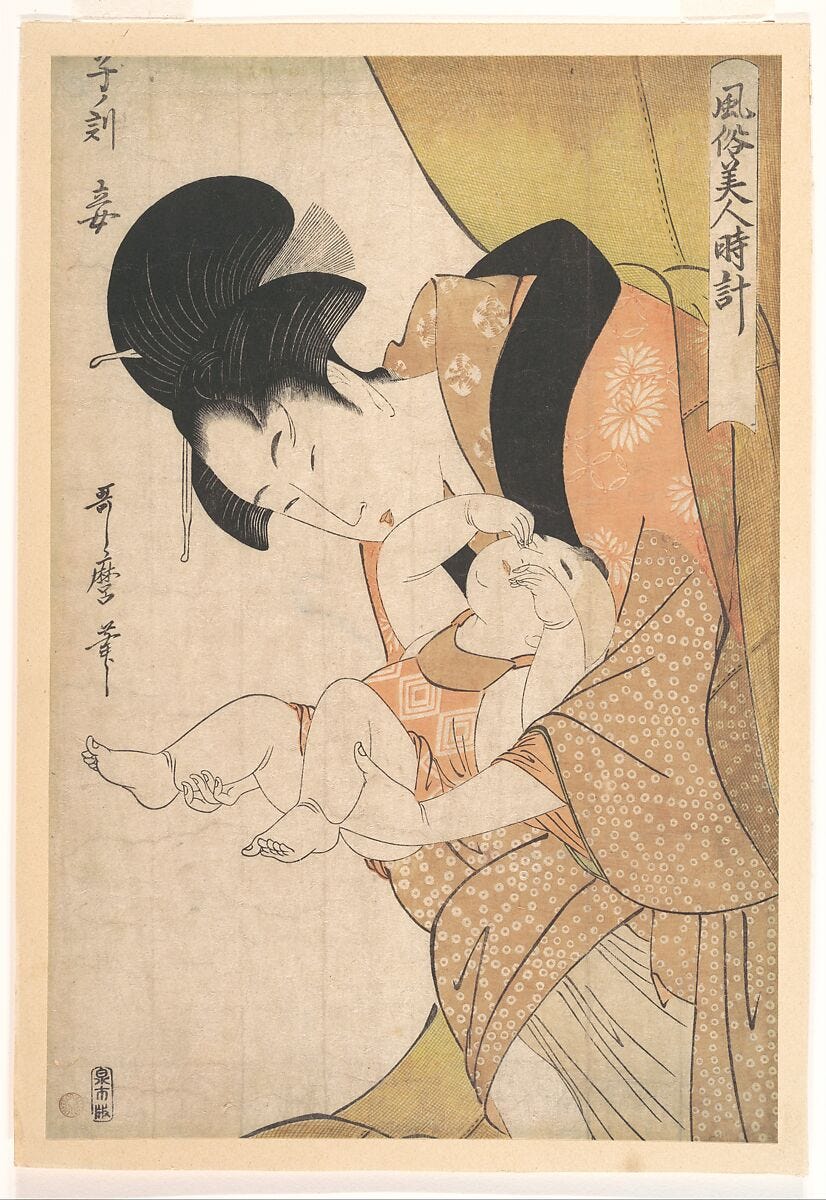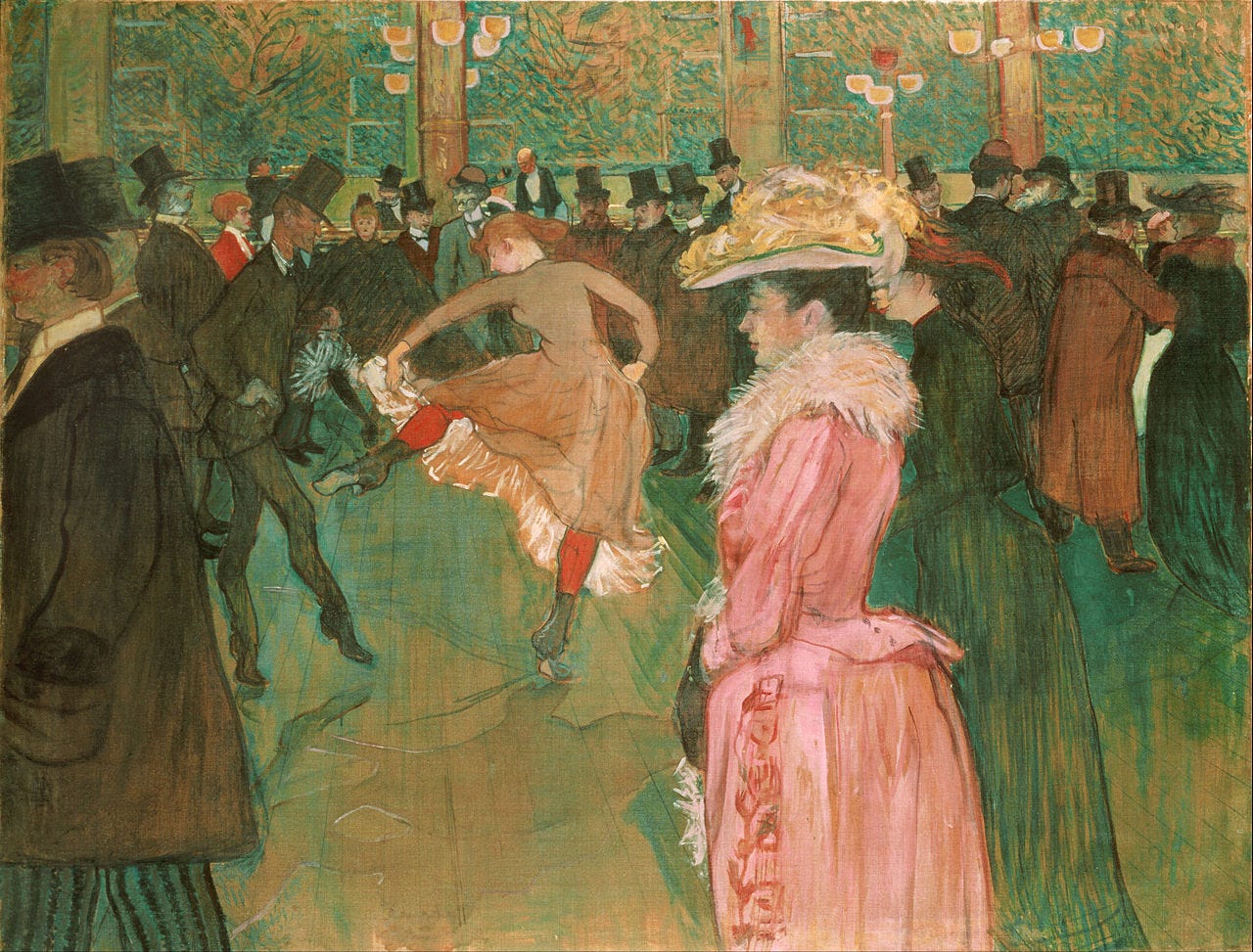Toulouse-Lautrec : A Night to Remember
Just a few days ago, I (very fortunately) found myself at a gentlemen's club while on a work trip, enjoying a dinner that felt like going back in time and momentarily stepping into a 19th-century soirée. Picture lavish decor, stylish company, bottomless cocktails, and an infectious laughter filling the air as we engaged in an impromptu midnight game of pool. It was a scene alive with the easiness and vibrancy that defines a quintessential French soirée.
In that moment, I was captivated by the artworks adorning the walls of the establishment. One colorful piece, in particular, strikingly evoked the style of Henri de Toulouse-Lautrec (1864-1901), one of the most celebrated artists of the French Post-Impressionist movement who brilliantly captured the vibrant Paris nightlife of the late 19th century.
On that evening, the atmosphere around me felt as though it had sprung to life from one of his famous prints depicting nights in Montmartre. With his signature bright colors and flamboyant style, Toulouse-Lautrec invites us into this beautiful world of fleeting moments of joy, music, laughter - and perhaps a touch of hedonism.
Soirées de fin-de-siècle
Montmartre was undeniably the hotspot for any late 19th-century Parisian socialite in search of entertainment and excitement. This lively district welcomed a diverse mix of people—artists, writers, performers, and spectators alike. They all flocked to its cafés, cabarets, and (dare I say) brothels. As both a participant in, and keen observer of, Montmartre’s vibrant nightlife, Toulouse-Lautrec found rich inspiration in this milieu, portraying the iconic can-can dancers, actresses, and singers of the era. His most celebrated works include large printed posters commissioned by the Moulin Rouge, an iconic venue that epitomized the vibrant and often risqué nightlife of fin-de-siècle Paris.
At the Moulin Rouge, Henri de Toulouse-Lautrec (1892-1895)
Toulouse-Lautrec’s work celebrated a host of vibrant personalities from the Parisian nightlife; among them the lively can-can dancer La Goulue, known for the theatricality of her performances, and the graceful singer and dancer Jane Avril. He also immortalized cabaret star Aristide Bruant, easily recognized by his distinctive red scarf and bohemian style. Toulouse-Lautrec’s poster of Bruant not only captured his essence but also conveyed the colorful spirit of Montmartre. Through these iconic figures, Toulouse-Lautrec masterfully documented the allure and excitement of Parisian nightlife.
Jane Avril, Henri de Toulouse-Lautrec (1893)
Moulin Rouge: La Goulue, Henri de Toulouse-Lautrec (1891)
Aristide Bruant, in His Cabaret, Henri de Toulouse-Lautrec (1893)
Motion and Emotion
What stands out in Toulouse-Lautrec’s works is the palpable emotion that emanates from his scenes. His subjects are always in motion, embodying feelings of joy, intoxication, and an exuberant appreciation for hedonism. For example, in one scene, William Tom Warrener, an artist and close friend of Lautrec, appears as a top-hatted gentleman engaged in conversation with two female companions at the Moulin Rouge. The women's suggestive poses and Warrener’s flushed ear hint at the provocative nature of their discussion.
The Englishman at the Moulin-Rouge, Henri de Toulouse-Lautrec (1892)
In Toulouse-Lautrec’s art, the characters come alive through motions and movements. The gentleman is leaning forward as one of the ladies is stepping backwards. The subject’s feelings are almost tangible, ranging from the women's discomfort in this particular moment, to the sheer joy of dancing, vividly portrayed in Toulouse-Lautrec’s Moulin Rouge posters.
However, what truly sets Toulouse-Lautrec apart from his contemporaries is his ability to depict both the exuberance and the underlying melancholy of nightlife. He understood and depicted the darker aspects of the cabaret scene, revealing the fleeting nature of fame, the struggles of artists, and the ephemeral and fleeting joys of the night. His works allow us viewers to feel the simultaneous thrill and sadness or discomfort that intertwine within a same scene.
From Canvas to Print
Toulouse-Lautrec’s innovations extended beyond composition and subject matter. His techniques and use of various mediums were groundbreaking for his time. Initially trained in traditional painting, he eventually embraced the bold, graphic style of posters, which transformed the perception and consumption of art in late 19th century Paris.
Posters proved to be the perfect medium for capturing the vibrant essence of Parisian nightlife. Unlike traditional painting, which often focused on detail and depth, posters demanded immediacy and clarity, enabling Toulouse-Lautrec to convey dynamic narratives in a quickly produced format. His works, particularly those for the Moulin Rouge, showcased bold lines, bright contrasting colors, and memorable compositions that effectively caught the public’s attention. This shift made art more accessible to the masses by serving as an early example of mass marketing, but also elevated commercial art to a respected form of expression.
Divan Japonais, Henri de Toulouse-Lautrec (1893-1894)
A Touch of Japan
Toulouse-Lautrec’s fascination with prints was no mere coincidence; it was deeply influenced by Japanese art, particularly the ukiyo-e prints that gained popularity in France during the Japonisme movement. This movement, which emerged in the mid 19th century following Japan's opening to the West in the 1850s, sparked a widespread interest in Japanese aesthetics across Europe, especially in France.
Kabuki Actor Otani Oniji, Toshusai Sharaku (1794)
The Japonisme trend introduced artists and designers to a wealth of Japanese woodblock prints, textiles, and ceramics, inspiring them to incorporate these foreign elements into their own work. Key characteristics of this style included flat, decorative patterns, bold colors, asymmetrical compositions, and a focus on nature and everyday life.
Hour of the Rat: Mistress, from the series Women’s Daily Customs, Kitagawa Utamaro (1790)
For Toulouse-Lautrec, these techniques resonated deeply with his themes of ephemeral nightlife and entertainment. He embraced the techniques of Japanese art, using flat areas of color and strong outlines to simplify forms and enhance color contrasts in his own creations. This integration of Japanese aesthetics allowed him to experiment with composition and perspective, often depicting figures at unusual angles or employing dramatic cropping—elements that added a sense of immediacy and dynamism to his scenes.
Enjoy the Moment!
Reflecting on that dinner party I was fortunate enough to attend, I recall the vibrant energy that enveloped the room— fleeting moments of laughter and joy that very much echoed the spirit of Toulouse-Lautrec's work. Much like my night, alive with the carefree essence of any vibrant soirée, Lautrec’s art immortalizes the exuberance and transience of nightlife.
What sets Lautrec apart is his remarkable ability to capture both the thrill and the underlying melancholy of these experiences. Each character in his scenes tells a story of simultaneous joy and struggle. Through his bold colors and striking compositions, Lautrec not only encapsulated the desire for entertainment and escape that defined his era, but also explored the complexity of human emotion arising from any social interaction.
Ultimately, Toulouse-Lautrec reminds us viewers to enjoy these ephemeral moments—whether in the bustling halls of the Moulin Rouge or our own modern gatherings. Remember to have some fun!
At the Moulin-Rouge: The Dance, Henri de Toulouse-Lautrec (1890)










